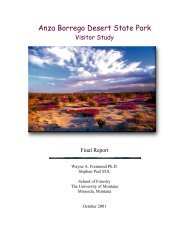Final Mitigated Negative Declaration and Response to Comments
Final Mitigated Negative Declaration and Response to Comments
Final Mitigated Negative Declaration and Response to Comments
You also want an ePaper? Increase the reach of your titles
YUMPU automatically turns print PDFs into web optimized ePapers that Google loves.
If a Federal agency is involved with the permitting, funding, or carrying out of a project that may<br />
result in take, then that agency must engage in a formal consultation with the Service.<br />
During formal consultation, the Federal agency, the applicant <strong>and</strong> the Service work <strong>to</strong>gether <strong>to</strong> avoid<br />
or minimize the impact on listed species <strong>and</strong> their habitat. Such consultation would result in a<br />
biological opinion by the Service addressing the anticipated effect of the project on listed <strong>and</strong><br />
proposed species. The opinion may authorize a limited level of incidental take.<br />
If no Federal agency is involved with the project, <strong>and</strong> federally listed species may be taken as part of<br />
the project, then you, the applicant, should apply for an incidental take permit. The Service may<br />
issue such a permit if you submit a satisfac<strong>to</strong>ry conservation plan for the species that would be<br />
affected by your project.<br />
Should your survey determine that federally listed or proposed species occur in the area <strong>and</strong> are<br />
likely <strong>to</strong> be affected by the project, we recommend that you work with this office <strong>and</strong> the California<br />
Department of Fish <strong>and</strong> Game <strong>to</strong> develop a plan that minimizes the project's direct <strong>and</strong> indirect<br />
impacts <strong>to</strong> listed species <strong>and</strong> compensates for project-related loss of habitat. You should include the<br />
plan in any environmental documents you file.<br />
Critical Habitat<br />
When a species is listed as endangered or threatened, areas of habitat considered essential <strong>to</strong> its<br />
conservation may be designated as critical habitat. These areas may require special management<br />
considerations or protection. They provide needed space for growth <strong>and</strong> normal behavior; food, water, air,<br />
light, other nutritional or physiological requirements; cover or shelter; <strong>and</strong> sites for breeding, reproduction,<br />
rearing of offspring, germination or seed dispersal.<br />
Although critical habitat may be designated on private or State l<strong>and</strong>s, activities on these l<strong>and</strong>s are not<br />
restricted unless there is Federal involvement in the activities or direct harm <strong>to</strong> listed wildlife.<br />
If any species has proposed or designated critical habitat within a quad, there will be a separate line for this<br />
on the species list. Boundary descriptions of the critical habitat may be found in the Federal Register. The<br />
information is also reprinted in the Code of Federal Regulations (50 CFR 17.95). See our Map Room page.<br />
C<strong>and</strong>idate Species<br />
We recommend that you address impacts <strong>to</strong> c<strong>and</strong>idate species. We put plants <strong>and</strong> animals on our c<strong>and</strong>idate<br />
list when we have enough scientific information <strong>to</strong> eventually propose them for listing as threatened or<br />
endangered. By considering these species early in your planning process you may be able <strong>to</strong> avoid the<br />
problems that could develop if one of these c<strong>and</strong>idates was listed before the end of your project.<br />
Species of Concern<br />
The Sacramen<strong>to</strong> Fish & Wildlife Office no longer maintains a list of species of concern. However, various<br />
other agencies <strong>and</strong> organizations maintain lists of at-risk species. These lists provide essential information<br />
for l<strong>and</strong> management planning <strong>and</strong> conservation efforts. More info<br />
Wetl<strong>and</strong>s<br />
If your project will impact wetl<strong>and</strong>s, riparian habitat, or other jurisdictional waters as defined by section<br />
404 of the Clean Water Act <strong>and</strong>/or section 10 of the Rivers <strong>and</strong> Harbors Act, you will need <strong>to</strong> obtain a
















